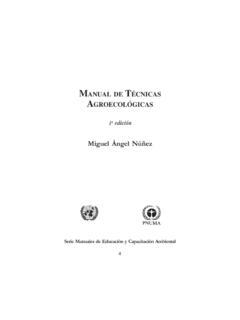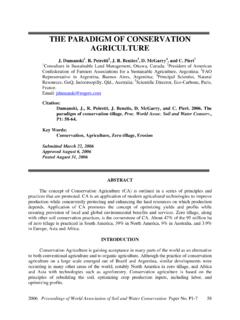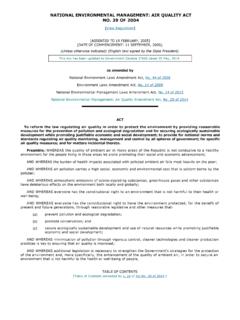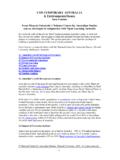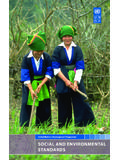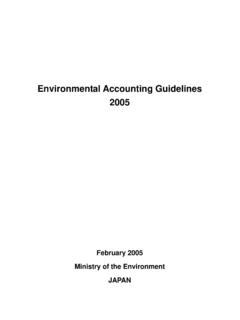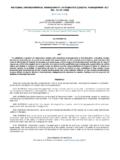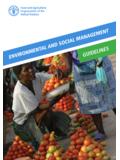Transcription of National Environmental Summary Saint Lucia 2010
1 National Environmental Summary Saint Lucia 2010 United Nations Environment Programme The National Environmental Summary (NES) for Saint Lucia has been developed by the United Nations Environment Programme (UNEP), with financing from the European Community (EC). It serves as an information tool to support the incorporation of environment as a component into the United Nations Common Country Assessment (CCA) and the United Nations Development Assistance Framework (UNDAF). This NES is intended to provide a critical analysis of gaps and opportunities that exist within the current policy/programme and National legislative framework used to address the major Environmental issues within the context of poverty reduction and development.
2 The contributions and support provided by the various Government agencies in Saint Lucia , regional organizations and international agencies in providing information and interviews are well acknowledged and appreciated. In particular, many thanks to Ms. Yasmin Jude of the Ministry of Physical Development and the Environment for her assistance in facilitating some of the interviews. UNEP/ROLAC (Regional Office for Latin America and the Caribbean) Coordination and Technical Supervision: Mark Griffith, PhD Senior Programme Officer Technical Review: Graciela Metternicht, PhD, Regional Coordinator, Division of Early Warning and Assessment UNEP-ROLAC Author: Asha Singh, PhD, Independent Consultant For John WILSON ecoNaturalResourcesManagmentConsulting Photo Credit on Cover Page.
3 Asha Singh, 2010 CARICOM Caribbean Community Secretariat CDB Convention on Biological Diversity CEHI Caribbean Environmental Health Institute CHM Clearing House Mechanism CPACC Caribbean Planning for Adaptation to Climate Change CRFM Caribbean Regional Fisheries Mechanism EIA Environmental Impact Assessment EC European Community FAO Food and Agricultural Organisation GEF Global Environment Facility IICA Inter-American Institute on Cooperation on Agriculture IWCAM Integrated Watershed and Coastal Area Management JICA Japan
4 International Cooperation Agency MACC Mainstreaming Adaptation to Climate Change MOU Memorandum of Understanding OECS Organisation of Eastern Caribbean States OAS Organisation of American States SMMA Soufriere Marine Park TNC The Nature Conservancy UNDP United Nations Development Programme UNEP United Nations Environment Programme UNFCCC United Nations Framework Convention on Climate Change UNFCCD United Nations Framework Convention to Combat Desertification Acronyms USAID United States of America International Development Executive Summary - - - - - - - - - 1 1.
5 Introduction and Background - - - - - - - 3 2. State of the Environment and Environmental Priorities - - - - 3 3. National Policy Responses - - - - - - - - 7 4. International Assistance Programmes - - - - - - 13 5. Critical Gaps and Opportunities to support country Environmental Priorities - 17 List of References - - - - - - - - - 20 Annex - - - - - - - - - - - 22 Table of Content The National Environmental Summary (NES) for Saint Lucia was prepared using a number of research support systems namely in-depth desktop reviews of scientific studies, National reports and documents along with interviews with key Environmental and technical experts.
6 The conclusions drawn from the study identified the Environmental priorities as follows: effects of climate change, air quality, pollution of many forms, land degradation, habitat loss and declining resources, deforestation, loss of access to beaches and squatting for housing and agriculture. The general consensus is that Saint Lucia has many policies and legislation aimed at responding to many of the issues, however these are somewhat fragmented and poorly implemented due to constraints posed by current institutional arrangements and lack of capacity (financial and human).
7 The absence of clear mandates in many institutions is another contributing factor to the low level of implementation and enforcement of Environmental legislation. In addition, participation in civil society in partnership management activities is low and as such, the public ownership needed to promulgate resource conservation and Environmental management is weak. Although efforts are being made to increase awareness, these are not continuous and are highly dependent on external funding. The common reasons for these Environmental problems are identified as limited/inadequate resources (financial and human), lack of holistic Environmental governance and the absence or weak political will to make needed policy shift for greater Environmental consideration in the development agenda.
8 The gaps and opportunities identified are tabulated under five broad headings and presented below. Summary OF GAPS AND OPPORTUNITIES 1. Resource Management Gaps Inadequate scientific data to support policy and programme response Inadequate Solid waste management Absence of a comprehensive Fisheries Management Policy and Plan Weak watershed management efforts Poor freshwater resource management Sustainable land management Energy efficiency Pollution Opportunities Decisions regarding sound sustainable management regimes could be better informed by a better regime of data collection.
9 A deficit in data and information regarding coastal processes and resources monitoring is influencing the way planning and management decisions are made A need for an integrated solid waste management policy which considers reuse and recycling also the new forms of waste that are emerging in St. Lucia A Fisheries Management Policy and Plan which takes into account St. Lucia s international, regional and National obligations and management issues An integrated water resource management regime To develop regulations for air quality Executive Summary 1 Summary OF GAPS AND OPPORTUNITIES To seeks alternative energy sources to reduce the reliance on imported fossil fuels 2.
10 Monitoring Gaps Long term monitoring of critical Environmental parameters in both the marine and terrestrial environment is absent Opportunities A coordinated monitoring programme/s which considers all the sectors (freshwater, coastal, forestry, air quality and the Environmental issues Greater surveillance and control in development projects and Environmental management 3. Environmental Governance: Implementation and Enforcement Gaps Limited implementation of policies and plans Poor Coordination and enforcement of laws and regulations Opportunities Saint Lucia has many policies but a significant number remain unimplemented because of limited capacity- human, institutional and financial.)
